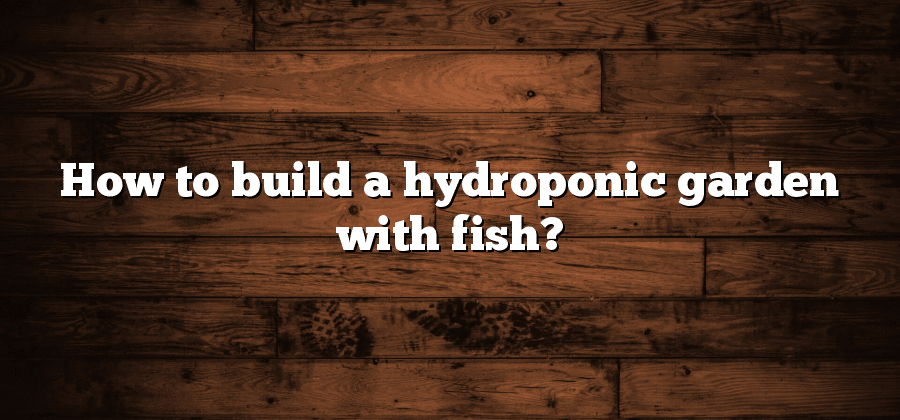Understanding Hydroponics and Aquaponics
Hydroponics and aquaponics are two innovative methods of growing plants without the use of traditional soil-based cultivation. Hydroponics involves growing plants in nutrient-rich water solutions, while aquaponics combines the cultivation of plants with the rearing of fish or other aquatic animals.
One of the major advantages of hydroponics and aquaponics is their ability to maximize space and minimize resource usage. With these systems, plants can be grown vertically, allowing for higher crop yields in a smaller area. Additionally, both methods reduce water consumption as the water is recirculated, minimizing waste. These sustainable practices make hydroponics and aquaponics appealing options for those looking to minimize their environmental impact.
Moving forward, as we explore the different aspects of hydroponics and aquaponics, it is essential to understand the underlying principles and techniques of these systems. By grasping the fundamentals, you will be equipped to select suitable plants and fish, design the layout of your garden, and choose appropriate growing mediums. So let’s dive deeper into the world of hydroponics and aquaponics and uncover how you can achieve optimal results in your own setup.
Selecting the Ideal Fish for Your Hydroponic Garden
When it comes to selecting the ideal fish for your hydroponic garden, there are several factors to consider. First and foremost, you need to choose fish that can thrive in an aquaponic system. Certain species, such as Tilapia, Trout, and Catfish, are known for their compatibility with hydroponics due to their ability to tolerate a wide range of water conditions.
In addition to considering fish species that are well-suited for hydroponics, you also need to take into account the specific requirements of your garden. Factors such as the size of your tank, the water temperature, and the availability of food should be considered when selecting fish. It is recommended to consult with an aquaponics expert or a local fish supplier to ensure that you choose fish that will not only thrive in your system but also complement your hydroponic plants.
Designing the Layout of Your Hydroponic Garden
When it comes to designing the layout of your hydroponic garden, there are several factors to consider. Firstly, you need to determine the space available for your garden. Whether it is a small corner of your backyard or a dedicated room indoors, understanding the space constraints will help you plan accordingly.
Next, think about the types of plants you want to grow. Some plants require more vertical space, while others need ample room to spread out horizontally. Consider the height and width each plant will require and plan the layout accordingly.
Another important aspect to consider is the accessibility of your garden. Make sure there is enough space to move around and tend to your plants comfortably. In addition to that, ensure that your layout allows for easy access to the necessary supplies and equipment, such as lighting systems, nutrient reservoirs, and irrigation systems.
Furthermore, consider the flow of water and nutrients throughout your hydroponic garden. Try to design a layout that allows for a seamless circulation system, ensuring that all plants receive adequate amounts of water and nutrients.
Lastly, keep in mind the aesthetic aspect of your garden. Consider the overall design and arrangement of your plants to create a visually pleasing and harmonious space.
By taking all these factors into account, you can design a layout for your hydroponic garden that maximizes space, accessibility, and productivity.
Creating the Water Circulation System for Aquaponics
When it comes to designing and implementing a water circulation system for your aquaponic setup, careful planning and consideration are essential. The water circulation system plays a crucial role in maintaining the health and well-being of your aquaponic system. It is responsible for ensuring that the water, nutrients, and oxygen are distributed evenly to both the fish tank and the grow bed.
One important aspect to consider when creating the water circulation system is the type of pump you will use. It is recommended to choose a pump that is energy-efficient and capable of handling the water volume of your aquaponic system. Additionally, consider the required flow rate for your specific set-up as it may vary depending on factors such as the number of fish, the size of the grow bed, and the type of plants you intend to grow. Proper filtration is also crucial in order to remove any solids and maintain water clarity, enhancing the overall health of your fish and plants.
In conclusion, the water circulation system is a fundamental component of any aquaponic setup. By carefully designing and implementing this system, you can ensure the optimal distribution of water, nutrients, and oxygen throughout your aquaponic system, resulting in healthy and thriving fish and plants.
Choosing the Right Hydroponic Growing Medium
Hydroponics is a method of growing plants without soil, where the nutrients are delivered directly to the roots through a nutrient-rich water solution. One crucial aspect of setting up a hydroponic garden is selecting the right growing medium. The growing medium plays a vital role in supporting the plant’s roots, providing oxygen, and helping with the absorption of nutrients.
When choosing a hydroponic growing medium, it’s essential to consider factors such as water retention capacity, pH neutrality, and ability to provide support for the plants. Some popular choices for hydroponic growing media include rockwool, which is made from volcanic rock and provides excellent drainage, and coconut coir, which retains moisture while allowing for good aeration. Other options, like perlite and vermiculite, offer lightweight and pH-neutral qualities. The choice of the growing medium will ultimately depend on the specific needs of the plants you intend to grow and the type of hydroponic system you are using.






